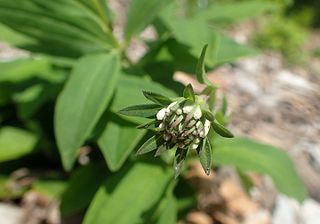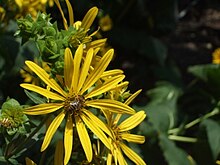
Aquilegia canadensis, the Canadian or Canada columbine, eastern red columbine, or wild columbine, is a species of flowering plant in the buttercup family Ranunculaceae. It is an herbaceous perennial native to woodland and rocky slopes in eastern North America, prized for its red and yellow flowers. It readily hybridizes with other species in the genus Aquilegia.

Liatris, commonly known as gayfeather and blazing star is a genus of flowering plants in the tribe Eupatorieae within the family Asteraceae native to North America. Some species are used as ornamental plants, sometimes in flower bouquets. They are perennials, surviving the winter and resprouting underground corms.

The Republican Study Committee (RSC) is a congressional caucus of conservative members of the Republican Party in the United States House of Representatives. In November 2022, Representative Kevin Hern of Oklahoma was elected as the chair of the RSC, effective as of January 2023.

Marshallia is a genus of plants in the tribe Helenieae within the family Asteraceae. Marshallia is native to the southeastern and south-central United States. A common name applied to most species in the genus is Barbara's buttons.

This is a list of lists of ghost towns in the United States by state.

The following outline is provided as an overview of and topical guide to the United States:

Calamovilfa is a genus of North American plants in the grass family native to the United States and Canada.

Diarrhena, or beakgrain, is a genus of Asian and North American plants in the grass family.

Nabalus is a genus of Asian and North American flowering plants in the tribe Cichorieae within the family Asteraceae.

Pityopsis is a genus of North American plants in the tribe Astereae within the family Asteraceae. Species of Pityopsis are known by the common names silkgrass or golden asters or grass-leaved goldenasters.
The Congressional Western Caucus is a caucus within the United States House of Representatives composed of 62 members. Although it has historically been bipartisan, it is currently composed almost exclusively of Republicans. It was founded by then-representatives James V. Hansen (R-Utah), Bob Stump (R-Arizona), Joe Skeen and Barbara Vucanovich (R-Nevada) in 1993 during the 103rd United States Congress. Despite its name, the Congressional Western Caucus has members from outside the Western United States, including as far east as New York City and Puerto Rico.

Croton monanthogynus is a species of flowering plant in the spurge family. The undersides are gray. It is a summer annual that produces small, inconspicuous flowers. The plant is monoecious and has both male and female reproductive organs in separate clusters on the same plant. Its leaves are alternate. It is native to the southeastern United States and the southern Great Plains. It is considered adventive in more northern states. AL, AR, AZ, GA, IA, IL, IN, KS, KY, LA, MD, MI, MO, MS, NC, NE, OH, OK, PA, SC, TN, TX, VA, WI, WV.

The Amash–Conyers Amendment was a proposal to end the "NSA's blanket collection of Americans' telephone records", sponsored by Justin Amash and John Conyers in the US House of Representatives. The measure was voted down, 217 to 205.
Diplomats in Residence (DIRs) are career Foreign Service Officers and Specialists located throughout the United States who provide guidance and advice on careers, internships and fellowships to students and professionals in the regions they serve. Diplomats in Residence cover 17 regions that encompass the United States and its territories. These Foreign Service officials have roles similar to those of corporate or collegiate recruiters: traveling in an assigned region, planning recruitment events, and acting as a resource for anyone interested in a career with the United States Department of State.
















